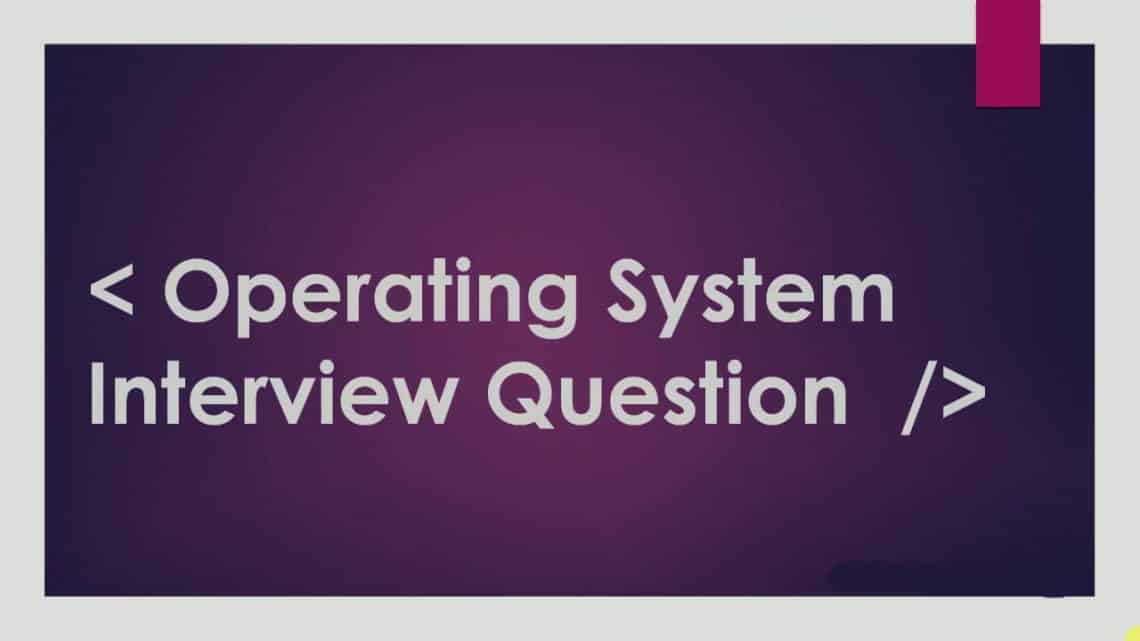Questions can be framed in several ways to check the fundamentals of operating system. Some important topics are important such as process management, memory management, disk access and file systems. With the process management talks about how process termination/creation, system calls, context switching works, scheduling and inter-process communication. Second, the memory management is regarding how it works, segmented/paged memory, physical organization, swap space, virtual memory, sharing, protection and much more. At last, disk access is broadly talking about hope is file system organized, nodes, what are things in which impact disk input/output and file permission. They can hire freelancers online in which gives selected questions and answers from operation system. A list of top interview questions and answers are frequently asked from an operating system that is given below.
Top interview questions and answers:
- Define operating system?
An operating system is a software program that acts as computer hardware to be communicated and operated with computer software. It is an important part of computer system without the computer is like a box.
- What are the purposes of an operating system?
There are 2 main purposes of an operating system that is given below:
- It provides an environment for an execution and development of programs.
- It designs to make sure that the computer system is performed well by managing OS computational activities.
- What are the different types of operating system?
- Batched operating systems
- Multi-programmed operating systems
- Real time operating systems
- Distributed operating systems
- Time-sharing operating systems
- Name the functions of an operating system?
The OS is controlled and coordinated by using hardware among many different applications and processes. It can provide various functionalities to users. The following are the main freelance jobs of an operating system.
- Resource allocation
- Process management
- File management
- Resource utilization
- Memory management
- I/O management
- Device management
- What is real time system?
The real-time system can use in case of required rigid time that has placed on a processor operation. It contains well defined and time constraints.
- What is socket?
The socket is used for making the connection between the two applications. At the end point of connection is called socket.
- What is kernel?
A kernel is a core and its important part of computer operating system, which can be provided as a basic service for all the parts of OS.
- Define monolithic kernel?
A monolithic kernel is one of the type of the kernel that can be included in all operating system codes into a single executable image.
- What is the difference between the macro kernel and microkernel?
Microkernel: It is a kernel in which can run minimum performance that is affecting services from an operating system. In the microkernel OS of all other operations are only performed by processor.
Macro kernel: It combines monolithic and microkernel. In this kernel, all operating system codes are in a single executable image.
- Define process and its types?
An executing program is called process. There are 2 types of process. They are:
- Operating system process
- User process
- What is the list of various states of a process?
- New process
- Ready process
- Waiting process
- Running process
- Terminated process
- What are the basic functions of process management?
Some of the important functions of process management are:
- Create and delete an operating system
- CPU scheduling
- Deletion and creation of users
- Synchronization and process communication
- What is a virtual memory?
Virtual memory is the one type of memory management techniques for letting a process executes an outside of memory. This is very useful specifically executing a program cannot be fitted into physical memory.
- Define deadlock?
Deadlock is a condition or situation where the 2 processes are waiting for each other to be completed. So they can start a new process. The resultant for both processes is to hang.
- What is reentrancy concept?
Reentrancy is used for memory saving technique that can be use in multi-program of time sharing system. It can provide much functionality that the multiple users are shared a single copy of program file at the same time. It has 2 key aspects. They are:
- The program code cannot be modified itself.
- Local data of each user process can separately.
- What are the sufficient and necessary conditions behind that the deadlock?
There are three necessary and sufficient conditions that are given below:
Hold and wait condition: It can specify that there is a process and allocate to hold a resource to it. If they are waiting for additional, then they are currently being held by another process.
Mutual exclusive condition: It is specified as a resource that is involved in the unshareable condition.
Circular wait condition: It is an explanation of the first condition. It is specified as a process in the form of system a chain or circular list where every process in the process of chain reaction is waiting for the resource held by the next process in a chain.
- What is a thread?
A thread is one of the basic units of CPU utilization. It can consists of the register set, stack, program counter and thread ID.
- Define FCFS?
FCFS is an acronym for First Come and First Served that is scheduling program type. In the scheme, if the process is requested to the CPU first, then it is allocated to the CPU. This implementation is managed by the process of hire freelancers online in FIFO queue.
- What are RAID and its different levels?
RAID is an acronym for Redundant Array of Independent Disk. It can be used to store same data redundantly and improved overall performance. Here are different RAID levels:
- RAID 0: Striped array of a disk without fault tolerance.
- RAID 1: Duplexing and mirroring
- RAID 2: Mirror style error correcting codes
- RAID 3: Bit interleaved parity
- RAID 4: Block interleaved parity
- RAID 5: Block interleaved distributed parity
- RAID 6: P + Q redundancy
- What is SMP?
SMP is an acronym for Symmetric Multi-Processing. It is the common type of multiprocessor system. In each processor, they can run identical copy of operating system. These copies are communicated with each other when required.
Summary:
Though, it is very good to keep interview questions and answers in mind and prepared well. However, companies or freelance jobs are asked operating system to check and understanding and also to see if you’re genuine interest in the computer. You can take more interest and dives in deep. Above mentioned interview questions are using simple and clear manner to keep your interest and curiosity tingling.


